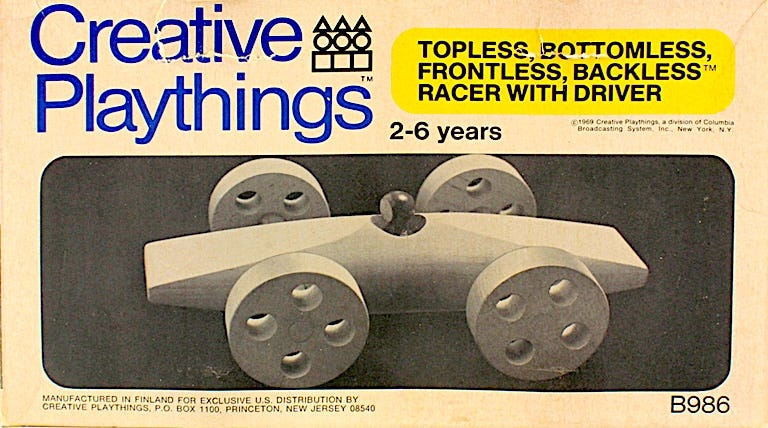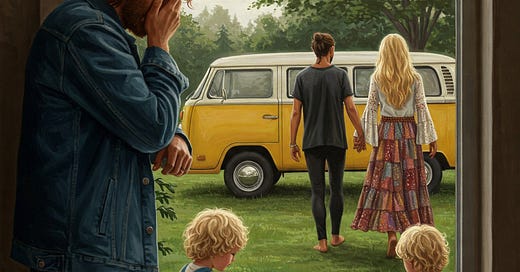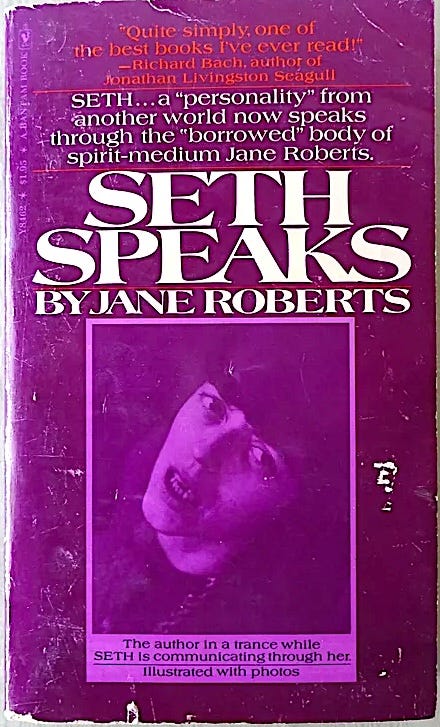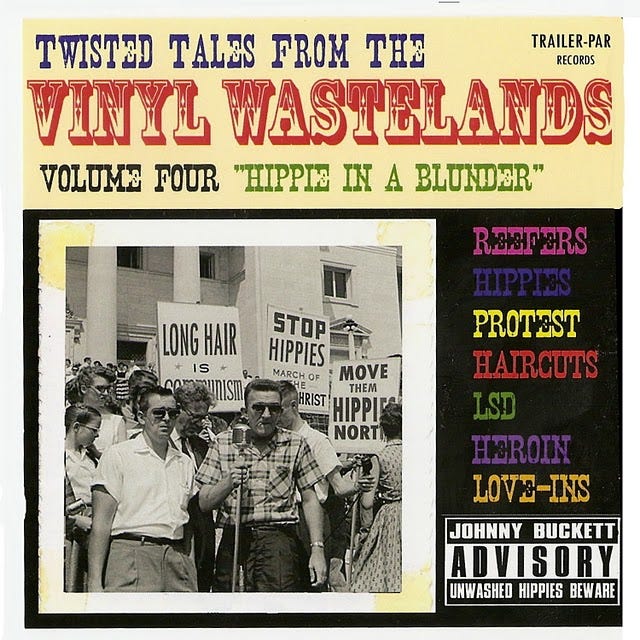TRACK 9: “Solar Broken Home”
Why did a tale of hippy love gone wrong strike so many Santa Fe funny bones?
I saw my two sons sitting
Behind the compost pile
Josh was telling little Jason
“Mom’s been gone a long long while
She left us our Creative Playthings
But she took the V.W. bus
She ran off with the Tai Chi instructor
And left daddy here with us.”
CHORUS:
Oh Sunshine if you hear me
You believe in ESP
Nothing seems too mellow
Since you deserted me
Who'll take care of Josh and Jason?
I can't do it all alone
Who's gonna feed them their little bowls of granola
In our solar broken home
A solar house out near Cerrillos
It was our dream come true
We were the envy of our old commune
And of our Seth group too
But now it seems so empty
I must escape reality
So I'll try to drown my sorrows
With my Red Zinger tea
(Repeat Chorus)
copyright Sidhe Gorm Music (BMI)
(written 1978)
Congratulations! You’ve made it to the post about what I believe is my most popular song.
More popular than “The Green Weenie”!
More popular than “Potatoheads’ Picnic” !
More popular than “The Ancient Ballad of Thundershaker McFrog”! (Only the most severely stricken die-hard Potatoheads will even halfway remember that one.)
Seriously, just about everyone living in Santa Fe in the 1970s knew at least one couple like the fictitious “Cauliflower,” the sad New Age hippie narrator of this tune (unnamed in the actual lyrics) and “Sunshine,” the woman that done him wrong.
I don’t think many people were familiar with the term “virtue signaling” back then. I certainly didn’t. But we all knew folks who practiced it annoyingly – talking about their passive solar houses out off the Turquoise Trail, their compost piles and their herbal teas.
Sometimes those folks were our dearest friends.
Sometimes they were us.
But even though “Solar Broken Home” might just be my most popular song, it’s also probably has more outdated references than any other tune I’ve ever written.
Do kids still play with Creative Playthings?
Today that company, which was founded in 1945, specializes in upscale playground equipment like wooden swing sets. But back in the 1960s and ‘70s they also made lots of little pricy wooden toys for the children, such as this toy car with its “Topless, Bottomless, Frontless, Backless” driver.

I heard many young parents back in those days -- shorty before I became a young parent -- smugly mention Creative Playthings, as if to imply these were much better for their little Joshes and Jasons than your mainstream, corporate Top 40 toys.
Red Zinger tea, which is a “flagship” tea of the Colorado-based Celestial Seasonings company, is still a thing. You can find it at most any major supermarket chain.
But back in the Daze, according to the company’s website, Celestial Seasonings co-founder Mo Siegel, “handpicked wild herbs from the Rocky Mountains in Colorado and used them to make our first tea. In the following years, he sold Mo’s 36 and 24 Herb Teas to health food stores, eventually selling them in hand-sewn muslin bags.”
In the early ‘80s the company was purchased by Kraft – because herbal teas go so well with cheap macaroni and cheese, I suppose. Kraft had it for just a few years.
In 1988, according to The Denver Post, the company was sold back to the old herb picker Siegel with the help of something called Vestar Capital Partners – which doesn’t sound like anything Sunshine or Cauliflower would be associated with.
Celestial later merged with a “natural food” company called the Hain Food Group. I don’t think this corporate entity sells underwear.
What are “Seth Groups”?
A couple of years before I wrote “Solar Broken Home,” I had a housemate named Ruth who was a devoted follower of Jane Roberts, author of Seth Speaks, The Seth Materials and other Sethy stuff.
“Seth” according to the website of the Seth Learning Center, “is the internationally acclaimed spiritual teacher who spoke through the author Jane Roberts while she was in trance, and coined the phrase `You Create Your Own Reality.’ Seth’s empowering message literally launched the New Age movement.”
For more on the Seth movement, check out this article by Canadian history writer E.R. Zarevich.
So there you go. And people who believed this stuff met in small groups around the country to study the wisdom of the mysterious Seth. I never attended any of their meetings, but my housemate Ruth frequently did.
But I have to point out that although she was always willing to talk about Jane Roberts and Seth, Ruth didn’t seem fanatical about it. She wasn’t intent on converting me or anyone I know of.
Indeed, Zarevich quotes one Seth fan saying Roberts “never aimed to become something like a sect leader or a God on Earth, but rather a writer who just so happened to have an uncanny connection with the Other Side.”
Seth couldn’t be reached for comment. I don’t think he’s had much to say since Roberts left this Earthly plane in 1984.
And even though I didn’t spell it out in the song, I think it’s obvious that the evil, nameless Tai Chi instructor, who cuckolded Cauliflower, was an Anglo with a wispy beard and man-bun.
I am not, by a long shot, the first songwriter to poke fun at hippie culture. It probably wasn’t very long after the first electric Kool-Aid acid test that novelty songs like this one by Ben Colder, aka Sheb Wooley (an actual relative of Roger Miller!) started getting released:
As documented in the delightfully warped CD compilation Twisted Tales from the Vinyl Wasteland Volume Four: Hippie in a Blunder, (where I first heard “The Love-In”), there was a rash of such songs coming from the edges of country music.
Most were lighthearted like Wooley’s song, lampooning draft-card burning, weed-smoking, love-in loving, long hair, etc. All from a conservative vantage point, naturally.
In fact most of these songs don’t stray far from the spirit of a joke I heard from an announcer at Rodeo de Santa Fe circa 1969:
Q: What’s the definition of a hippie?
A: A hippie is a jack who walks like a Jill and smells like a john.
Do I hear the sound of thousands of knees being slapped? Please don’t ask me why I sometimes forget where I parked my car but I remember dumbass jokes from nearly 60 years ago…
But a few of these “hippie” songs sounded downright hostile and fearful.
Some of these were by those angered by anti-war protests. Smokey Harless’ “A Place for Them Called Hell” is an example:
Had Fox News been around back then to promote it, Smokey could have been as big as Jason Aldean.
Of course, Hippie in a Blunder contains kilos of anti-drug numbers -- like Bud Freeman’s “Because of LSD,” “Marijuana The Devil’s Flower” by Johnny Price and this Wendell Austin classic – which I first heard by the amazing T. Tex Edwards – “LSD.”
But I like to think my little hippie novelty song I’m is more in tune with ex-Fug Ed Sanders’ “Jimmy Joe, the Hippybilly Boy.”
These old New Age tropes were a big part of the song, and usually got the most laffs – even from those who’d heard it hundreds of times. But these aren’t what actually inspired me to write it.
My chief inspiration was a sad old Merle Haggard song, “Holding Things Together,” in which the narrator’s lost love was not named Sunshine. She was Alice, who perhaps was a honky-tonk angel who went back to the wild side of life.
Prepare for heartache:
One person who immediately caught on about the origin of “Solar Broken Home” was my old pal Erik Ness. I played him the song not long after I’d written in and by the second chorus, he began singing along -- with the lyrics of Hag’s tune.
Knowing this was supposed to be a country weeper, I knew it was a job for Tom Dillon. So I called him in to augment The Whereabouts with his steel guitar.
These days Tom’s still all modest about his steel playing, always pointing out that in 1981 he was just learning the instrument. But I believed he’d learnt it pretty darn well by the time we recorded this tune. He made the damn thing bawl its eyes out!
I’ve always loved the solo part he shared with my brother Jack before the last verse. But here’s a little secret: On the original vinyl record, Jack’s solo came first, then Tom’s. But when re-mixing it in the mid ’90s for the CD version, we decided to put Tom’s solo first, then Jack’s.
Sorry, vinyl freaks, but I still believe this CD mix is the best.
Another weird fact about this tune: It’s one of — Hell, maybe the only — one of my songs covered by another singer. My former Santa Fe New Mexican colleague K.C. Compton recorded a version with her acoustic band Checked Past when she lived in Kansas City.
And, in a recent text she told me it was “a crowd favorite.”
I was honored.
Even though KC cut “Seth groups” out of the lyrics in her version.
But Seth never complained. So far.
And K.C. isn’t the only other singer who’s performed “Solar Broken Home.” Back in the mid 1980s, when I was working at the Albuquerque Journal’s Northern Bureau, my editor got a call from a friend saying Joan Baez was singing over at El Farol.
The last of us late filers finished up whatever stories we were working on and headed up to Canyon Road, hoping to catch Joan in action.
When we walked in, she was there, standing in front of a table leading her audience in some upbeat gospel song. Everyone in the joint was singing and clapping along.
I don’t know for sure but I think Ms. Baez planned that tune to be her grand finale for the impromptu show. She sat down at the table to enjoy a drink and talk to folks.
But there were a handful of my old Forge crowd there. And one of them (was it you, Suzanne?) started calling, “Hey, Steve! Play `Solar Broken Home.’” Then other old Forge-types joined in: “Yeah! Play `Solar Broken Home.’”
Then someone handed me a guitar. What could I do?
I saw my two sons sitting …
I looked at Joan, who was sitting across the table from me and she seemed into it, laughing at the right parts. And by the second chorus, she was singing along.
Joan Baez! Singing one of my songs!
Just a great night for my ego. Just for a few precious moments, Joan Baez was my background singer.
Now enjoy my song:
Get your own copy of Picnic Time for Potatoheads & Best-Loved Songs from Pandemonium Jukebox HERE
Credits:
Steve Terrell, lead vocals, acoustic rhythm guitar
Jack Clift: lead guitar, producer
Mike Roybal: bass
David Valdez: drums
Tom Dillon: steel guitar








I loved that I happened to be at the bar on the night Joan Baez and you sang together!
(It made up a little for missing Stevie Wonder at the Palace)
It was a wonder to witness the way that crowd ballooned as word went out; the place filled to the rafters in just minutes.
I was introduced to Joan that night and told her that I had once worked with her father, expecting to see a spark of love light her eyes. Instead she said something like ‘Bully for you!’ and turned away, making it clear she had nothing to say about dear old Dad. So I was interested to see that she discusses her estrangement from him in the movie “I am a Noise,” confirming the communication telegraphed to me more than 30 years earlier in El Farol.
I remember Sheb Wooly from his long stint as Pete Nolan on the Rawhide TV series. And as Ben Colder he had one radio hit that my dad thought was a riot, "Son Don't Go Near the Eskimos." I was surprised to learn from Wiki that he also composed and recorded "Purple People Eater" and the theme song to the Hee Haw show, among many others.
Novelty songs and songwriters have a rich and proud tradition in American music, and you, cousin, have done your part.